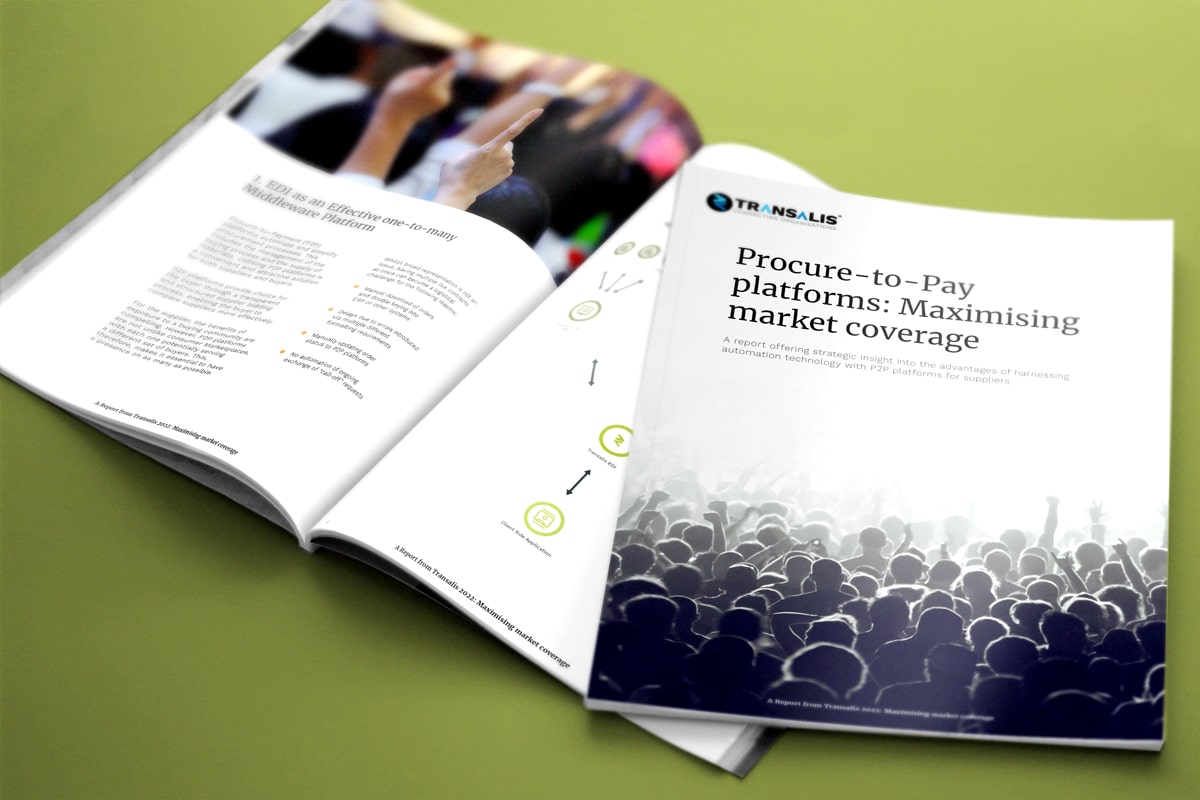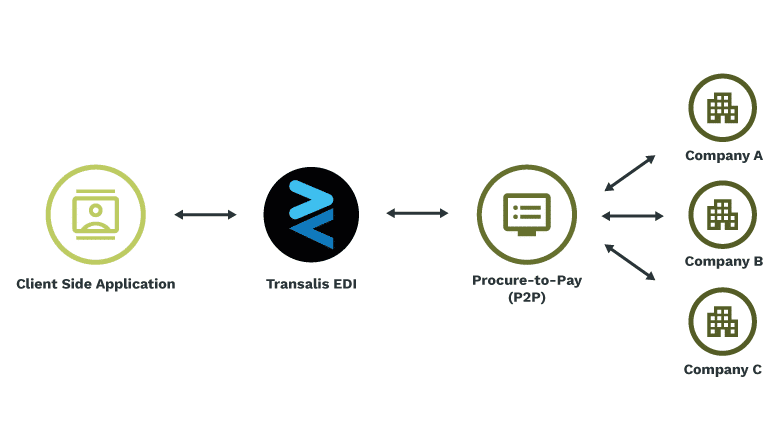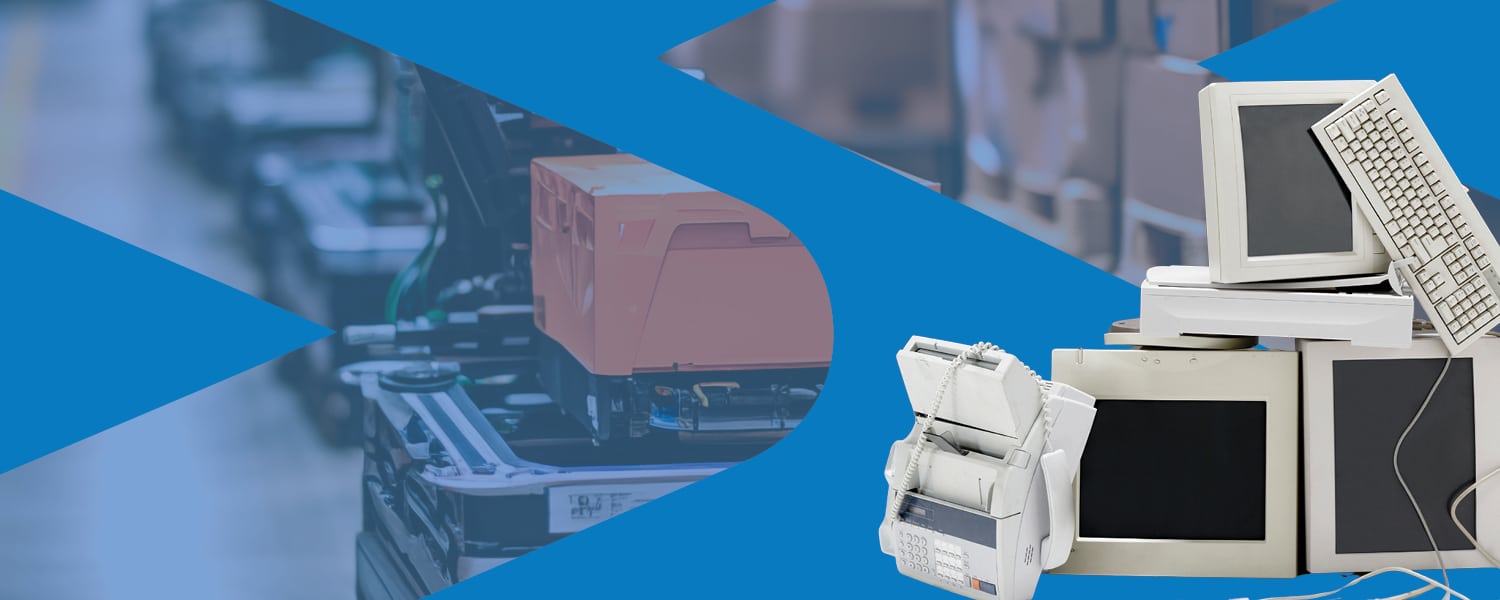
Implementing a strategy to ensure market reach is a challenge in the current economic climate, but this is where middleware integration comes in.
Middleware solutions are a great way to integrate with multiple platforms simultaneously. This is exactly what a client required us to implement for their Procure-to-Pay (P2P) platforms and associated customers.
Procure-to-Pay platforms: Maximising market coverage
Get your free copy of our whitepaper. Perfect for B2B suppliers looking to innovatively expand their market reach.

In this blog, we explore how P2P middleware solutions enable organisations to take advantage of marketplace functionality on procurement platforms. This includes extracts from our report, Procure-to-Pay platforms: Maximising market coverage, as well as snippets from our detailed client case study.
Middleware meaning
Firstly, it is probably best to start with a definition of middleware.
In short, a middleware solution is software that sits in the “middle” between applications and other systems to enable connectivity between them. A key benefit and differentiator of middleware services, in comparison to other solutions, is that they can support one-to-many connections.
For example, as will be discussed further in this blog, organisations that require integrated data communication between their ERP system and their network of Procure-to-Pay platforms can deploy an EDI middleware solution. By taking this approach, the organisation avoids the hassle and expense of setting up individual connections and integrations for each P2P platform. Ultimately, the middleware software acts as a funnel layer that processes data exchanges between each party and feeds it into the required endpoint.
What is Procure-to-Pay?
Similarly, before getting into the detailed strategy, it is important to define what Procure-to-Pay means.
As the name suggests, Procure-to-Pay platforms automate procurement processes. They are independent applications that are onboarded by organisations, similar to those that are used to manage finance. An organisation’s choice of Procure-to-Pay solution can depend on its size, the complexity of its operations or the industry vertical it is in. For example, organisations in the hospitality industry may opt for the Birch Street P2P platform, or those in the construction industry may choose Causeway P2P.
Overall, P2P platforms simplify many of the functions required for the:
Effective procurement of materials
Management of the buying process
Supply of materials
In addition to the digitisation and automation of procurement processing, many P2P platforms also provide a marketplace function. This is where B2B organisations can list their available products in an online catalogue, and buyer organisations can place orders directly through the platform.
We discuss the strategic use of this particular P2P platform feature to benefit B2B suppliers further in this blog.
Advantages of Procure-to-Pay platforms
Utilising P2P platforms is a convenient and attractive solution for both suppliers and buyers.
For the supplier

The benefits of additional market exposure are very compelling. P2P platforms offer more opportunities for the B2B supplier on top of their traditional sales channels.
For the buyer

P2P platforms provide choice through a transparent and structured supplier bidding process. This enabling effective supplier comparison.
The challenges
P2P platforms are not unlike consumer Marketplaces, with each one potentially serving a different set of buyers. This, therefore, makes it essential to have a presence on as many as possible. However, for those that do have multiple P2P connections, the potential of manually managing multiple live contracts simultaneously is a significant challenge.
Whilst broad representation is not an issue, having multiple live contracts at once can become a logistical challenge for the following reasons:
Manual download of orders and double keying into ERP or other systems
Delays due to errors introduced via multiple different formatting requirements
Manually updating order status to P2P platforms
No automation of ongoing exchange of “call-off” requests
P2P middleware integration
Leveraging middleware integration as a one-to-many solution will resolve the issues described above. Also, importantly, utilising EDI middleware delivers both significant cost savings and operational efficiency.
This is because, by definition, P2P middleware pulls the required P2P platform connections onto a single integration layer. Therefore, these connections are combined into one SaaS solution, as opposed to multiple, thus significantly saving on costs. Automating the data exchanges between parties, as well as feeding this data into the correct endpoints, also removes a number of time-consuming and error-prone manual processes.
The below workflow outlines how middleware integration functions:

Businesses new to these solutions will need to research providers that have the right capabilities to support a project like this. Bear in mind that legacy EDI providers are unlikely to have the expertise to build a middleware integration solution. Both existing and new users of EDI should entrust the build of their middleware services with a provider that has demonstrated experience.
Transalis has just that, a client case study where we implemented a middleware solution is summarised in the section below.
Middleware integration in practice
A client came to us after they acquired the majority division of an office supplies business. Through this acquisition, the client uncovered a time-sensitive issue regarding the existing P2P platforms this business division was connected to.
The existing P2P middleware service was being withdrawn imminently, with a 90-day hard deadline. Furthermore, following the acquisition, the client had very limited in-house knowledge of P2P processing management. In terms of scale, this was a very large project, with over 300 individual customers, spread across 15 different P2P platforms.
For Transalis, the main objective was to ensure that the client could maintain Business As Usual (BAU) for all of their customers from the moment the new middleware solution was pushed live. This meant automating as much of the order communication as possible and then feeding it into the right endpoints. For this purpose, the solution implemented by Transalis leveraged the flexibility and scalability of APIs to manage these processes. Our team worked on a modular basis, mapping out consistencies between different connections, and then focusing on the differences.

In summary, Transalis delivered the full middleware solution before the deadline, with all customers and platforms onboarded within 9 weeks. All necessary trading documentation (e.g. orders, invoices, Advance Shipment Notices) was successfully routed from the customer and P2P platform, then translated and reformatted for integration into the client’s ERP system.
Since this initial stage, the client has entrusted Transalis with expanding the project to include an additional 100+ customers. Transalis has also been named as their digital solutions provider of choice for all future projects.
Embarking on your middleware project
As touched on before, organisations that are new to this type of solution need to be able to trust that their chosen provider can deliver.
So, research SaaS providers that offer this service and can outline a structured onboarding strategy for successful and timely delivery. Large and complex projects, such as the case study mentioned, can fall off track if not properly scoped or managed during the initiation stages.
Transalis have APIs for all the major P2P platforms, for a full listing visit our integrations page. In fact, our eDI Connect+ product bundle includes one P2P integration as standard.
eDI Software
To discuss your middleware integration project with our helpful team, contact us on 0845 123 3746 (UK callers) or +44 1978 369 343 (international callers), or via email sales@transalis.com. There’s also a wealth of resources in our Knowledge Hub, including our quarterly whitepaper reports and client case studies.











